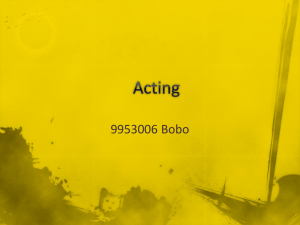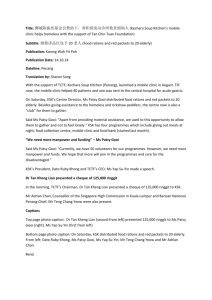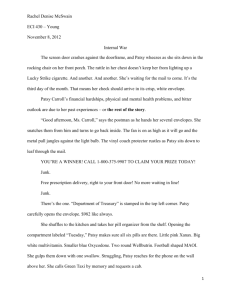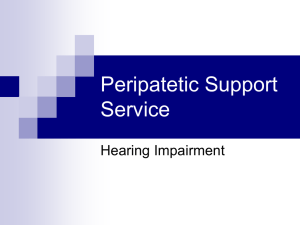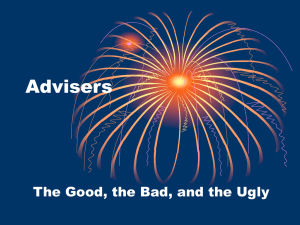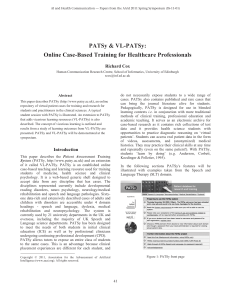THE INSITE MODEL
advertisement
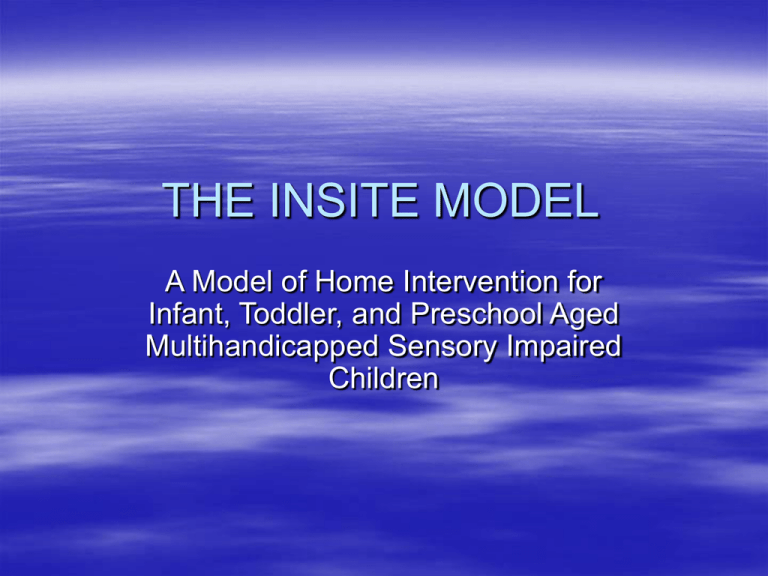
THE INSITE MODEL A Model of Home Intervention for Infant, Toddler, and Preschool Aged Multihandicapped Sensory Impaired Children SPE 552 LA 5 THE INSITE MODEL Created by: Julie Tilley Sara Smith James Hale Home-based programs such as THE INSITE MODEL may be used with children who are medically fragile. These are children who: may not demonstrate an understanding of daily routines, gestures, or other communication skills. often show limited recognition of significant persons in the environment demonstrate little purposeful movement display little reaction to stimuli such as noise, movement, touch, etc. rarely function above the six-month level during the early home program. WHAT THE INSITE MODEL IS: A support model for families of multi-handicapped sensory impaired infants, toddlers, and pre-school aged children Home-based services which may also include care-givers in a day care setting An early intervention service obtained through referrals, public awareness, and high-risk screening An intervention done after diagnosis and medical clearance are given A parent-based intervention which is guided/taught by a parent advisor WHAT THE INSITE MODEL IS NOT: A norm-referenced test Administered in a standardized test setting A numbers-based assessment comparing one child to another Programs addressed by THE INSITE MODEL: Vision Hearing Cognition Communication Motor impairment Developmental Resources EACH OF THE SIX PROGRAM TOPICS INCLUDES: parent goal list of materials needed instructions for the parent advisor sample discussion for advisor and parent sample activities sample challenges supplemental/reference materials RESPONSIBILITIES OF THE PARENT ADVISOR: Become familiar with the guidance material contained in the “Information for Parent Advisors” section of the manual. Plan and deliver home visits. Provide emotional support to the family. Arrange for other support services as necessary. THE VISION PROGRAM: Contains a comprehensive series of topics on the visual system, eye disorders, eye specialists, and exams Promotes the development of various visual skills such as looking, eye-hand/ eye-foot co-ordination, recognition, and discrimination skills. Helps parents understand visual loss. Teaches parents skills to help their child make use of his or her residual vision. THE HEARING PROGRAM CONTAINS: Hearing Aid Management * includes the treatment of hearing disorders * teaches the parents how to manage the hearing aids * consists of nine associated topics Auditory Development *develops attention to sounds and voices along with the child’s awareness of his/her own vocalizations * encourages recognition of sound sources and increased vocalization * presents auditory input in meaningful, interesting activities COGNITION PROGRAM: Focuses on the sensorimotor stage of development—usually birth to three years. Enables parents to promote early thinking skills in their child. Includes seven topics: introduction object exploration gestural imitation means-end causality object permanence spatial relationships. COMMUNICATION PROGRAM: Forms a crucial aspect of family programming Establishes a communication relationship that involves their child Addresses three main issues: creating an environment that foster communication (bonding) using informal communication (cues and gestures) using formal communication (signals, signs, and words) Includes thirteen topics covering bonding, touch, face-to-face contact, facial expression, intonation, turn-taking, cuing, playing with the child, teaching the child to play with toys, varying positions, varying locations, and exploring the indoors. MOTOR IMPAIRMENT PROGRAM: Involves a team effort between parent, parent advisor, and any therapists who may be working with the child Teaches parents to understand the child’s motor delays, demonstrates correct handling and positioning of the child, obtain and use adaptive equipment, recognize feeding problems and how to ease them, and understand the importance of their roles in helping their child develop Contains thirteen topics 5 which deal with understanding delayed posture and movement and 8 which involve dealing with delayed posture and movement. DEVELOPMENTAL RESOURCES: GROSS MOTOR, FINE MOTOR, SELF-HELP, AND SOCIALEMOTIONAL DEVELOPMENT Four sections which cover each of the four developmental areas Each section contains an introduction which includes a listing of the type of skills in that developmental area, a discussion on the normal developmental sequence for each, information on how impairments affect the development of each skill, and suggestions/resources to facilitate the planning of activities for a particular skill area SAMPLE DESCRIPTION OF THE CHILD SERVED BY THE INSITE MODEL Patsy is a 12-month old girl who was born three months prematurely resulting in a mild sensorineural hearing loss and visual impairment. She appears to be intelligently intact with good motor skills. Patsy has near-normal hearing when wearing her hearing aids but she has had repeated middle ear infections. She lives with her natural parents and is beginning to babble, sit alone, and sees light, shadows, and movement of bright shiny visual targets. SAMPLE TOPIC INCLUDED IN THE VISION PROGRAM Parent Goal: Parent will learn about size and distance factors and how to use these to enhance Patsy’s vision. Parent Advisor Instructions: Assign the parents a few activities to try during the week that will help them observe how Patsy functions. Materials: examples of books; visual toys and materials Patsy is able to respond to and manipulate. Sample Discussion: Decreased acuity means Patsy will have to move closer to people or objects in order to see them more clearly. Or, if she additionally has a field loss, it may reduce the amount of the target that she sees at one time. Remember that Patsy’s eyes are working very hard. Be aware that she may become fatigued and have a shorter attention span for objects that are close. Continued: Sample Toddler Activity: Encourage the parent to look at books with Patsy. Choose books like PAT THE BUNNY that are less cluttered than other children’s books. Sample Toddler Challenge: Help Patsy learn to recognize familiar people or objects in large photographs. Then see if she can recognize them in smaller photographs.
